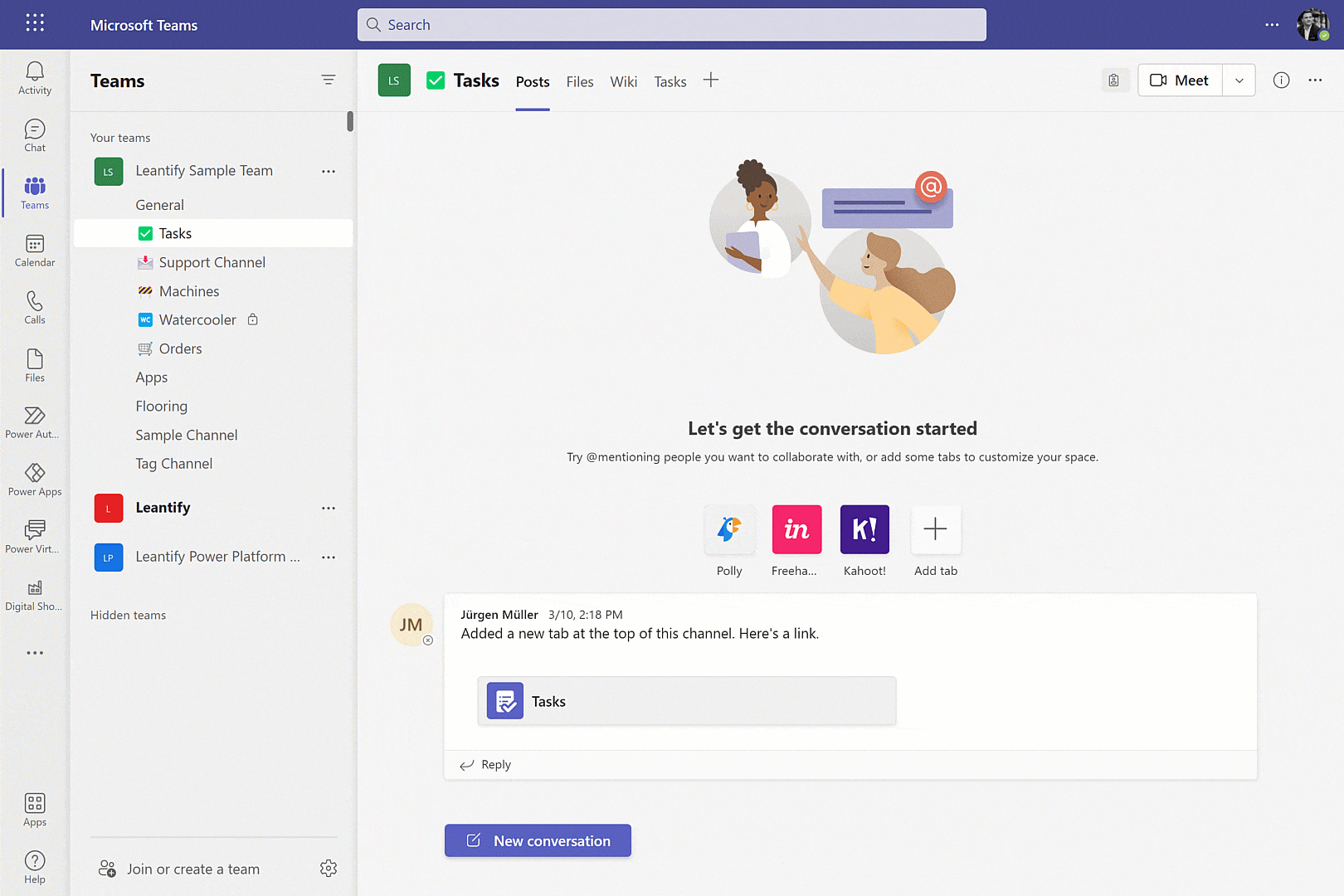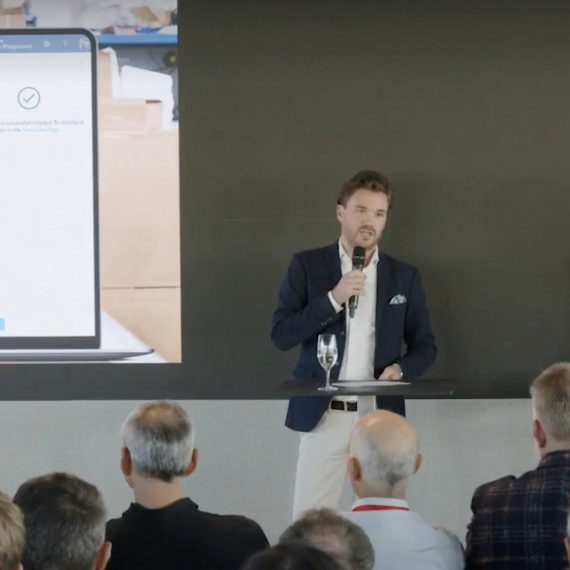In many companies, virtual chats and online meetings have become as commonplace as a coffee break. But what about digital ways of working that have a more significant impact – such as automating processes using low-code platforms, for example? We found out the answers to this in an interview.
Modern work equipment makes it possible to rethink inefficient or paper-based processes, opening up huge potential. However, there is often a lack of IT specialists to further develop processes in a way that is truly beneficial. One possible solution is to democratise digitalisation, or, to put it simpler terms, develop employees from consumers into digital makers. In an interview with Sebastian Zolg and Edona Elshan, they describe how this works. Sebastian Zolg is a Digital Workplace Architect and Microsoft MVP 2022 at Swisscom, while Edona Elshan is a post-doctoral researcher at the Institut für Wirtschaftsinformatik (institute for business information systems) at the University of St. Gallen (HSG).
Sebastian Zolg, companies are moving their data and collaboration to the cloud as part of the digital transformation. What are the benefits of this for companies?
Sebastian Zolg: The cloud promises better, faster and more efficient collaboration. Some every-day examples of such cloud-based collaboration include collaborative document editing, digital whiteboards, virtual chats, video telephony and screen sharing.
Has the cloud made our daily work life easier?
Sebastian Zolg: Honestly, no. The hybrid world makes everything much more complex. Collaboration has become more independent in terms of the time you spend and where you are. But processes are much more fragmented now. We need to work on these processes and adapt them to this new world. The problem is that a large portion of the IT budget goes into what are known as flagship projects, which are often part of CRM, HR, MIS or ERP systems. They are large-scale, often multi-year in nature and tie up a considerable amount of IT resources and budgets. On the other hand, there are many small-scale, more fragmented processes – often referred to as long-tail processes – that are either not digital or do not take advantage of the opportunities offered by the cloud. Since these are like the proverbial sand in the gearbox, it would be worthwhile to digitalise or update them. There is tremendous potential in this area.
How can companies navigate the challenges posed by of flagship projects and limited IT budgets?
Sebastian Zolg: The solution lies in democratising digitalisation. To be able to do this, employees need to be made active participants in digitalisation and no longer just be passive consumers – rather, they need to be able to help participate and contribute their own ideas as digital makers. It’s only in this way that digitalisation can be implemented sustainably and successfully in the company, regardless of limited IT budgets.
So that would mean that employees would develop their own solutions?
Edona Elshan: Yes. That’s where low-code platforms come into play. It means that even employees without programming knowledge are able to build digital solutions quickly and easily. This allows ideas from departments to be implemented directly and tested with users. On the one hand, this improves collaboration between departments and, on the other, enables the company to react more quickly to changes.

‘A company’s willingness to embrace this new technology and create a culture that promotes digital solutions like low code is key.’
Edona Elshan, University of St. Gallen
With low code, applications can be developed via a graphical interface with drag-and-drop elements instead of traditional programming language, which is usually faster and more cost-effective. How did HSG become aware of low code?
Edona Elshan: Last year, we conducted an interview study in Swiss companies to highlight the various fields of application of low-code platforms and to analyse the opportunities and risks. We currently see a significant need for digitalisation in SMEs and in companies with a shortage of IT specialists. Managers in these companies often report to us that they are dissatisfied with process efficiency in their companies. Digitalisation projects often fail due to insufficient IT capacity or high costs, which quickly make the business case unprofitable. Based on our market observations, we see low code as an effective tool for digitalisation projects. As a result, we carried out several case studies with different companies from different industries to explore the requirements for introducing low-code platforms and the potential benefits that they offer.
So low code enables more initiative and more agility – what does that mean in concrete terms? Do you have any examples?
Sebastian Zolg: At Swisscom, we use the Microsoft Power Platform for low code – primarily due to the fact that it can be well integrated with Microsoft 365 and Microsoft Teams. This integration in combination with modern collaboration makes things become particularly exciting. We can think ahead and ask ourselves how we can further simplify existing processes and incorporate the new cloud tools.

We also see great potential in the industries. An example from digital production is where we integrate system fault notifications so that they trigger a push notification to the technicians directly in Microsoft Teams. They then acknowledge the assignment directly in the chat. Departments themselves can also define additional functions of a workflow such as this. What we are seeing with this is the link between core business and modern collaboration, which opens up an almost endless number of possibilities.
What is the situation on the market? Which industries use low code?
Edona Elshan: As part of our investigations, we looked further at various industries and came across a large number of different application scenarios. We found that low code can be used in almost every industry and that the spectrum of application scenarios is also very broad. These range from the automation of email processes, to the development of applications for rail transport, to the implementation of temporary applications such as a coronavirus information app. Low code’s flexibility enables companies to implement individual requirements in a quick and cost-effective way, thereby creating real added value.
So the demand for low code is there – the technology is ready. What requirements does a company have to meet to start using it?
Edona Elshan: Companies need to be aware that low-code technology may sound simple, but it still requires a learning curve. A company’s willingness to embrace this new technology and create a culture that promotes digital solutions is key. It is also important to empower and encourage employees to work on these solutions. The company needs to support the transformation in order to exploit the full potential of low code. In addition, it is essential to acquire some basic knowledge in order to be able to use the technology effectively and optimise processes. This understanding will enable companies to fully take advantage of the benefits of low code to improve their processes and increase their efficiency.
Sebastian Zolg: It is essential to support employees. At Swisscom, we are working on a low-code adoption framework. We teach employees in various roles how to use these technologies, which requires clear structures for those responsible from the business. They need to know what they’re doing. And of course, this also applies to governance and IT. We need to avoid a situation where hundreds of new business apps and workflows are created and then fall at the feet of the IT department. We create transparency in this regard through a Center of Excellence and active portfolio management for low-code apps.

‘Combining our core business and modern collaboration with low code opens up an almost endless number of opportunities.’
Sebastian Zolg, Swisscom
Edona, do you teach your students the necessary low-code basics at the HSG?
Edona Elshan: Of course! We not only teach our business economics students a basic understanding of technology, but we also use these technologies as part of further education so that they can learn in practice. Our students have the opportunity to use low-code development tools to create websites or applications. One example of this is the development of chatbots that respond to customer queries. We believe that low-code development is a key part of the modern business world, and we want to make sure that our students learn the skills required to use this technology.
What are your main thoughts on low code?
Sebastian Zolg: Modern collaboration needs to be more than just virtual chats and screen sharing. Tools such as Teams also need to integrate the core business. With Teams and Power Platform, the possibilities are endless, and processes can be completely rethought. It is important that employees are included in the digitalisation process as active shapers in order to turn digital consumers into digital makers. This promotes innovation, increases agility and creates real added value for the company.
Edona Elshan: In order to meet the demands of the constantly changing labour market, it is essential to continuously acquire new skills. The necessary in the area of low-code development are in particular demand at the moment. The workers who have mastered these skills are more competitive on the labour market and can open up new career opportunities.
How to get started with Power Platform
Would you like to benefit from an increase in efficiency in your company and are looking for a suitable introduction to the Microsoft Power Platform? Benefit from our advice and our comprehensive know-how.




